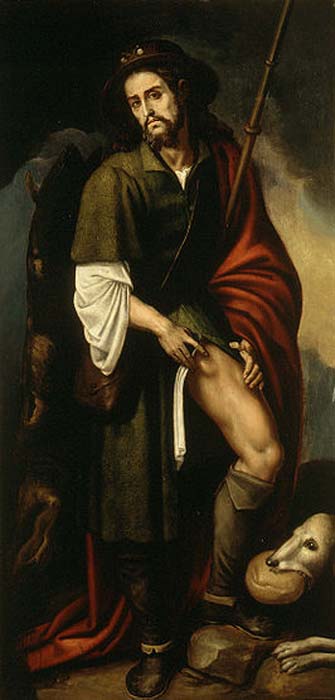
Have You Ever Heard of An Animal Being Made a Saint? It Really Happened!
Saint Guinefort is perhaps one of the most unusual saints in Christianity. This unique 13th century saint was not even a human being, but a greyhound. Following his brave protection of a baby, which culminated in his death, and reports of miracles occurring at his grave site, Guinefort was declared a ‘saint for the protection of infants’.
St. Roch
According to one source, the story of St. Guinefort begins with that of St. Roch, the patron saint of dogs. During his life, St. Roch administered to the sick. His interaction with these people, however, eventually resulted in the saint becoming a victim of the plague as well. He was then driven out to a forest, where he was left to die. It was St. Roch’s dog, apparently named Guinefort, who brought food to the saint until he got well. When St. Roch died, his dog went to live with a noble family.
While it seems like a nice connection, the problem with the association between St. Roch and St. Guinefort is that the story of the dog-saint originated in the 13th century, whilst St. Roch lived during the subsequent century, which means that it is unlikely that these two figures were related.

Saint Roch. (Public Domain)
Guinefort’s Story
St. Guinefort’s story can be found in a piece of work known as De Supersticione, which was written by Stephen de Bourbon, a medieval historian and inquisitor who lived during the 13th century. de Bourbon records that he came across the story of St. Guinefort whilst he was in Lyon, France, where he was “preaching there against sorcery and hearing confessions”. During his time, he heard many women confess to carrying their children to St. Guinefort, and he decided to inquire further into the matter.
- Cerridwen: Mother, Magician, and Crone from Old Welsh Mythology
- A Loyal Companion and Much More: Dogs in Ancient China
- The Spanish use of Animals as Weapons of War

Place Carnot, Lyon (Public Domain)
de Bourbon found that St. Guinefort was a greyhound belonging to a certain lord of a castle. This castle was located on the land belonging to the lord of Villars-en-Dombe, close to a place called Villeneuve. The lord had a wife and a baby son. One day, the lord, his wife, and the baby’s nurse left their home, leaving the baby in his cradle. During the time whilst they were away, a snake – a traditional symbol of evil at that time – entered the home, and was making its way towards the child. Guinefort, who was left with the baby, saw the serpent and attacked it. After a fight, the greyhound succeeded in killing the snake, and threw it away from the cradle. The snake’s blood, however, was smeared on the cradle, as well as on the dog’s mouth and head.
When the nurse came back, she saw the bloody mess. Thinking that Guinefort had killed and devoured the baby, she let out a loud cry, which alerted the child’s mother. When she saw the scene in the room, she too screamed, which brought her husband to the room. The lord drew his sword, and killed the dog. When the three approached the cradle, they saw that the child was unharmed, and sound asleep. They also saw the body of the snake that was killed by Guinefort. Ashamed of what they had done to the faithful dog, they threw his body into a well in front of the castle gate, placed a large heap of stones over it, and planted some trees nearby as a memorial.

The snake lies in pieces by the cradle as the father decapitates Guinefort. (Public Domain)
Venerated as a Martyr
It was only later when the local peasants heard of the dog’s story that they began to visit the place, and venerated the dog as a martyr in the hopes that it would intercede on their behalf. De Bourbon claims that these villagers “were seduced and often cheated by the Devil so that he might in this way lead men into error.” However, many reported miracles occurred at the site of his grave, and eventually locals declared him a saint for the protection of infants.
- Dogs, Ancient and Modern: A Mythological History
- Not Always A Man’s Best Friend: Terrifying Black Dogs of British Legends
- Researcher Presents Evidence for Cherished Role of Prehistoric Dogs in the Siberian Arctic

Painting of Guinefort and the snake. (4.bp.blogspot)
Although St. Guinefort has never been recognized by the Catholic Church (de Bourbon’s work, for instance, shows the kind of opposition being made by the church hierarchy), the holy dog’s faithful followers have paid homage to him all the way into the 20th century.
Featured image: An image showing the story of St. Guinefort. Photo source: Adam Davis
By Wu Mingren
References
ChurchPOP Editor, 2017. Man’s Best Saint? The Bizarre Story of the Canine Folk Hero St. Guinefort. [Online]
Available at: https://churchpop.com/2016/09/30/mans-best-saint-the-bizarre-story-of-the-canine-folk-hero-st-guinefort/
de Bourbon, S., De Supersticione [Online]
[Hyams, P. (trans.), 1877. de Bourbon’s De Supersticione.]
Available at: http://sourcebooks.fordham.edu/halsall/source/guinefort.asp
de Courtecadeno, M. v. T., 2006. Guinefort: The Sainted Dog of France. [Online]
Available at: http://www.florilegium.org/?http%3A//www.florilegium.org/files/ANIMALS/Guinefort-art.html
Dickey, C., 2013. A Faithful Hound. [Online]
Available at: http://www.laphamsquarterly.org/roundtable/faithful-hound
Lynn, M. R., 2017. The Cult of Guinefort: An Unusual Saint. [Online]
Available at: http://www.ultimatehistoryproject.com/the-cult-of-guinefort-an-unusual-saint.html
Weir, A., 2017. A Holy Dog and a Dog-headed Saint. [Online]
Available at: http://www.beyond-the-pale.co.uk/dogsaints.htm















